Taguchi Optimization of Roundness and Concentricity of a Plastic Injection Molded Barrel of a Telecentric Lens
Abstract
:1. Introduction
2. Theoretical Analysis
2.1. Flow Analysis during Filling Stage
2.2. Shrinkage and Warpage
2.3. Stress Analysis after the Demolding Stage
2.4. Roundness Evaluation
2.5. Concentricity Evaluation
3. Methods and Procedures
3.1. Material Characteristics and P-v-T curves of PA66
3.2. Modeling of Analyzed Product
3.3. Taguchi Design Method
3.4. Least Squares Circle Method for Evaluation of Roundness and Concentricity
4. Results and Discussion
4.1. Factor Rank Analysis and Optimal Process Parameters
4.2. Correlation between Overall Roundness and Overall Concentricity
4.3. Deformation and Shrinkage of Plastic Barrel
4.4. Manufacturing and Processing Implications of Present Results
5. Conclusions
- This study has successfully employed a hybrid Taguchi/CAE simulation approach to determine the optimal processing conditions which minimize the overall roundness and overall concentricity errors of an optical telecentric barrel produced using the plastic injection molding technique.
- The overall roundness and overall concentricity of the optical barrel are determined mainly by the packing pressure, melt temperature, and cooling time. Both properties can be improved by increasing the packing pressure, reducing the melt temperature, and extending the cooling time.
- The overall roundness and overall concentricity of the molded barrel are positively correlated with one another. Thus, an appropriate selection of the processing conditions optimizes both the overall roundness and the overall concentricity simultaneously.
- The holder structure added to the side of the lens barrel induces a local volume shrinkage effect which causes an axial deformation of the barrel. However, the optimal processing conditions reduce the overall volume shrinkage rate of the barrel from 4.409% (standard processing conditions) to 3.465% and reduce the overall deformations of the barrel from 0.592 mm (standard processing conditions) to 0.469mm. This paper successfully improves the overall roundness and overall concentricity in the vicinity of the holder structure accordingly.
Author Contributions
Funding
Institutional Review Board Statement
Informed Consent Statement
Acknowledgments
Conflicts of Interest
References
- Lu, X.; Khim, L.S. A statistical experimental study of the injection molding of optical lenses. J. Mater. Process. Technol. 2001, 113, 189. [Google Scholar] [CrossRef]
- Beaumont, J.P. Runner and Gating Design Handbook: Tools for Successful Injection Molding; Hanser Gardner Publications: Cincinnati, OH, USA, 2004. [Google Scholar]
- Lin, C.M.; Hsieh, H.K. Processing optimization of Fresnel lenses manufacturing in the injection molding considering birefringence effect. Microsyst. Technol. 2017, 23, 5689–5695. [Google Scholar] [CrossRef]
- Lin, C.M.; Chen, Y.W. Grey optimization of injection molding processing of plastic optical lens based on joint consideration of aberration and birefringence effects. Microsyst. Technol. 2019, 25, 621–631. [Google Scholar] [CrossRef]
- Lin, C.M.; Chen, W.C. Optimization of injection-molding processing conditions for plastic double-convex Fresnel lens using grey-based Taguchi method. Microsyst. Technol. 2020, 26, 2575–2588. [Google Scholar] [CrossRef]
- Wieme, T.; Duan, L.; Mys, N.; Cardon, L.; D’hooge, D.R. Effect of Matrix and Graphite Filler on Thermal Conductivity of Industrially Feasible Injection Molded Thermoplastic Composites. Polymers 2019, 11, 87. [Google Scholar] [CrossRef] [Green Version]
- Pham, N.T.-H. Characterization of Low-Density Polyethylene and LDPE-Based/Ethylene-Vinyl Acetate with Medium Content of Vinyl Acetate. Polymers 2021, 13, 2352. [Google Scholar] [CrossRef]
- Miks, A.; Novak, J. Design of a double-sided telecentric zoom lens. Appl. Opt. 2012, 51, 5928–5935. [Google Scholar] [CrossRef] [PubMed]
- Tong, Y.; Guofan, J.; Junguo, Z. Design of image-side telecentric freeform imaging systems based on a point-by-point construction-iteration process. Chin. Opt. Lett. 2017, 15, 77–81. [Google Scholar] [CrossRef]
- Peng, J.; Wang, M.; Deng, D.; Liu, X.; Yin, Y.; Peng, X. Distortion correction for microscopic fringe projection system with Scheimpflug telecentric lens. Appl. Opt. 2015, 54, 10055–10062. [Google Scholar] [CrossRef]
- Lifu, W.; Zhu, J.; Xie, H. Single-lens 3D digital image correlation system based on a bilateral telecentric lens and a bi-prism: Validation and application. Appl. Opt. 2015, 54, 7842. [Google Scholar]
- Liu, X.; Liu, Z.; Duan, G.; Cheng, J.; Jiang, X.; Tan, J. Precise and robust binocular camera calibration based on multiple constraints. Appl. Opt. 2018, 57, 5130. [Google Scholar] [CrossRef] [PubMed]
- Quinn, M.; Spinosa, E.; Roberts, D. Miniaturisation of pressure sensitive paint measurement systems using low-cost, miniaturised machine vision cameras. Sensors 2017, 17, 1708. [Google Scholar] [CrossRef] [Green Version]
- Ye, X.W.; Dong, C.Z.; Liu, T. A review of machine vision-based structural health monitoring: Methodologies and applications. J. Sens. 2016, 2016, 1–10. [Google Scholar] [CrossRef] [Green Version]
- Li, X.; Qiao, T.; Pang, Y.; Zhang, H.; Yan, G. A new machine vision real-time detection system for liquid impurities based on dynamic morphological characteristic analysis and machine learning. Measurement 2018, 124, 130–137. [Google Scholar] [CrossRef]
- Xu, Y.; Brownjohn, J.M. Review of machine-vision based methodologies for displacement measurement in civil structures. J. Civ. Struct. Health Monit. 2018, 8, 91–110. [Google Scholar] [CrossRef] [Green Version]
- Xiaojun, W.; Gao, G. LED light design method for high contrast and uniform illumination imaging in machine vision. Appl. Opt. 2018, 57, 1694. [Google Scholar]
- Yang, J.; Li, X.; Xu, J.; Cao, Y.; Zhang, Y.; Wang, L.; Jiang, S. Development of an optical defect inspection algorithm based on an active contour model for large steel roller surfaces. Appl. Opt. 2018, 57, 2490. [Google Scholar] [CrossRef]
- Paul Drake, J.R. Dimensioning & Tolerancing Handbook; McGraw-Hill: New York, NY, USA, 1999. [Google Scholar]
- Henzold, G. Geometrical Dimensioning and Tolerancing for Design. In Manufacturing and Inspection; Elsevier: Amsterdam, The Netherlands, 2006. [Google Scholar]
- Roy, R.K. Design of Experiments Using the Taguchi Approach; John Wiley & Sons: Hoboken, NJ, USA, 2001; p. 538. [Google Scholar]
- Taguchi, G. System of Experimental Design; Kraus International Publications: White Plains, NY, USA, 1985; Volumes 1–2. [Google Scholar]
- Tang, S.H.; Tan, Y.J.; Sapuan, S.M.; Sulaiman, S.; Ismail, N.; Samin, R. The use of Taguchi method in the design of plastic injection mould for reducing warpage. J. Mater Proc Technol. 2007, 182, 418–426. [Google Scholar] [CrossRef]
- Beaumont, J.P.; Nagel, R.; Sherman, R. Successful Injection Moulding—Process, Design and Simulation; Hanser: Gardner, NY, USA, 2002. [Google Scholar]
- Pervez, H.; Mozumder, M.S.; Mourad, A.H.I. Optimization of injection molding parameters for HDPE/TiO2 nanocomposites fabrication with multiple performance characteristics using the Taguchi method and Grey relational analysis. Materials 2016, 9, 710. [Google Scholar] [CrossRef] [Green Version]
- MOLDEX3D. Available online: http://support.moldex3d.com/2021/en/index.html (accessed on 4 October 2021).
- Rudolph, N.; Osswald, T.A. Polymer Rheology: Fundamentals and Applications; Hanser: Gardner, NY, USA, 2014. [Google Scholar]
- Malloy, R. Plastic Part Design for Injection Molding; Hanser: Gardner, NY, USA, 1994. [Google Scholar]
- MOLDEX3D. Available online: https://www.moldex3d.com/moldex3d-help/ (accessed on 4 October 2021).
- Menges, G.; Mohren, I.P. How to Make Injection Molds; Hanser: Gardner, NY, USA, 1986. [Google Scholar]
- Annicchiarico, D.; Jeffrey, R.A. Review of Factors that Affect Shrinkage of Molded Part in Injection Molding. Mater. Manuf. Process. 2014, 29, 662–682. [Google Scholar] [CrossRef]
- Fischer, J.M. Handbook of Molded Part Shrinkage and Warpage—Determination of Shrinkage; Beckley, B., Ed.; Plastics Design Library/William Andrew Pub.: Norwich, NY, USA, 2003. [Google Scholar]
- Liu, F.; Zeng, S.; Zhou, H.; Li, J. A study on the distinguishing responses of shrinkage and warpage to processing conditions in injection molding. J. Appl. Polym. Sci. 2012, 125, 731–744. [Google Scholar] [CrossRef]
- Bower, A.F. Applied Mechanics of Solids; CRC Press: Boca Raton, FL, USA; Taylor & Francis Group: Oxfordshire, UK, 2009. [Google Scholar]
- Sui, W.; Zhang, D. Four Methods for Roundness Evaluation. Phys. Procedia 2012, 24, 2159–2164. [Google Scholar] [CrossRef] [Green Version]
- Ahn, S.J. Least Squares Orthogonal Distance Fitting of Curves and Surfaces in Space; Springer: Berlin, Germany, 2004. [Google Scholar]
- Srinivasan, V.; Shakarji, C.M.; Morse, E.P. On the enduring appeal of least-squares fitting in computational coordinate metrology. J. Comput. Inform. Sci. Eng. 2011, 12, 011008. [Google Scholar] [CrossRef]
- Shunmugam, M.S. Criteria for computer-aided form evaluation. J. Eng. Ind. 1991, 113, 233–240. [Google Scholar] [CrossRef]
- Kim, N.H.; Kim, S.W. Geometrical tolerances: Improved linear approximation of least-squares evaluation of circularity by minimum variance International. J. Mach. Tools Manuf. 1996, 36, 355–366. [Google Scholar] [CrossRef]
- Hichem, N.; Pierre, B. Evaluation of roundness error using a new method based on a small displacement screw. Meas. Sci. Technol. 2014, 25, 044012. [Google Scholar]
- GD&T BASICS. Available online: https://www.gdandtbasics.com/concentricity (accessed on 4 October 2021).
- Berman, M.; Culpin, D. The statistical behaviour of some least squares estimators of the centre and radius of a circle. J. R. Statist. Soc. B 1986, 48, 183–196. [Google Scholar] [CrossRef]
- Landau, U.M. Estimation of a circular arc center and its radius. Comput. Vis. Graph. Image Process. 1987, 38, 317–326. [Google Scholar] [CrossRef]





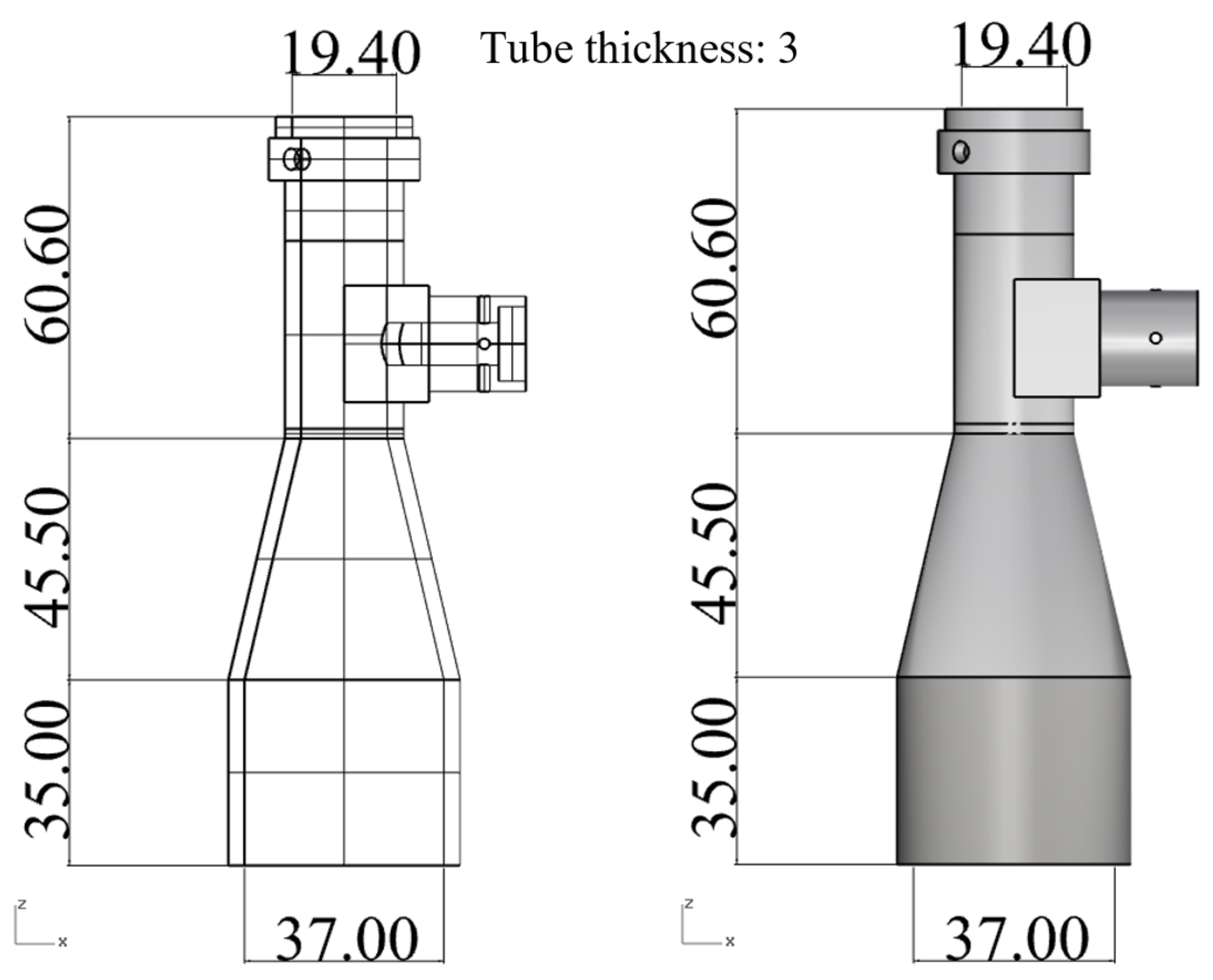

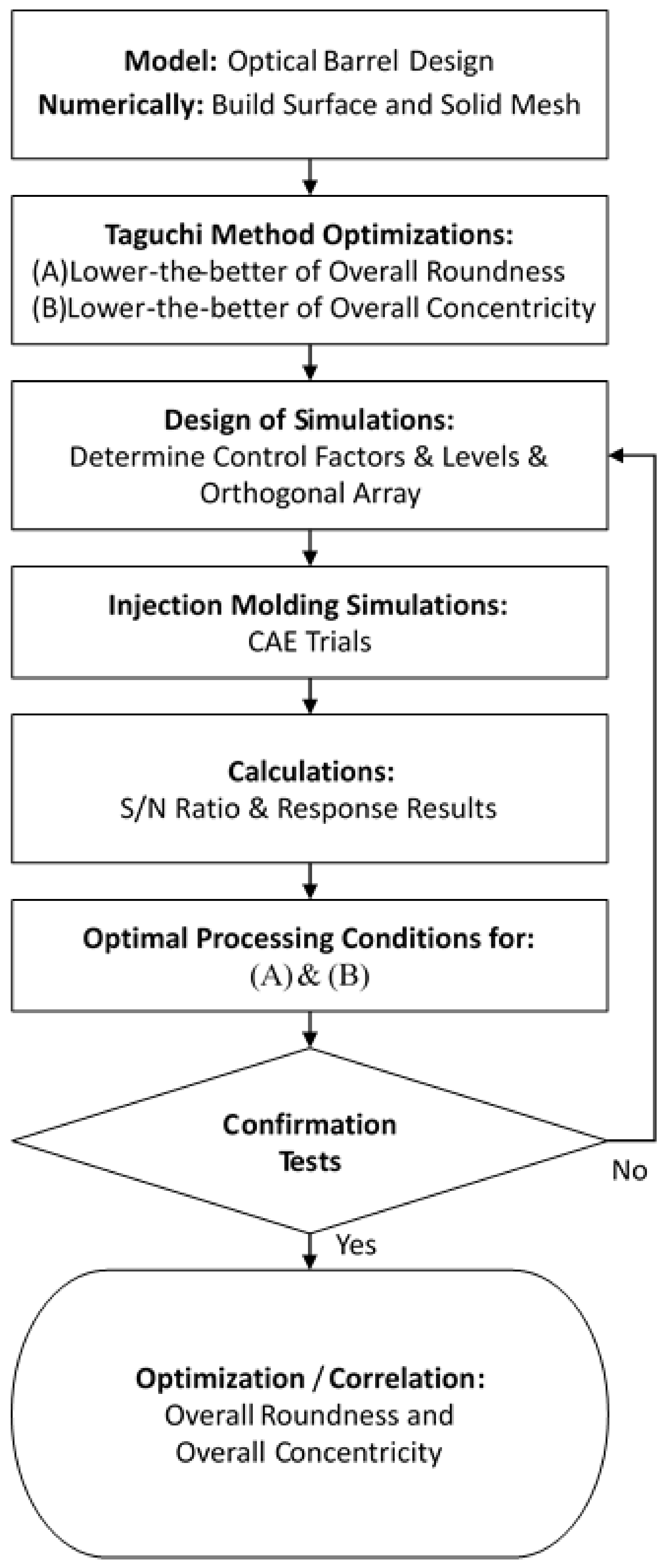
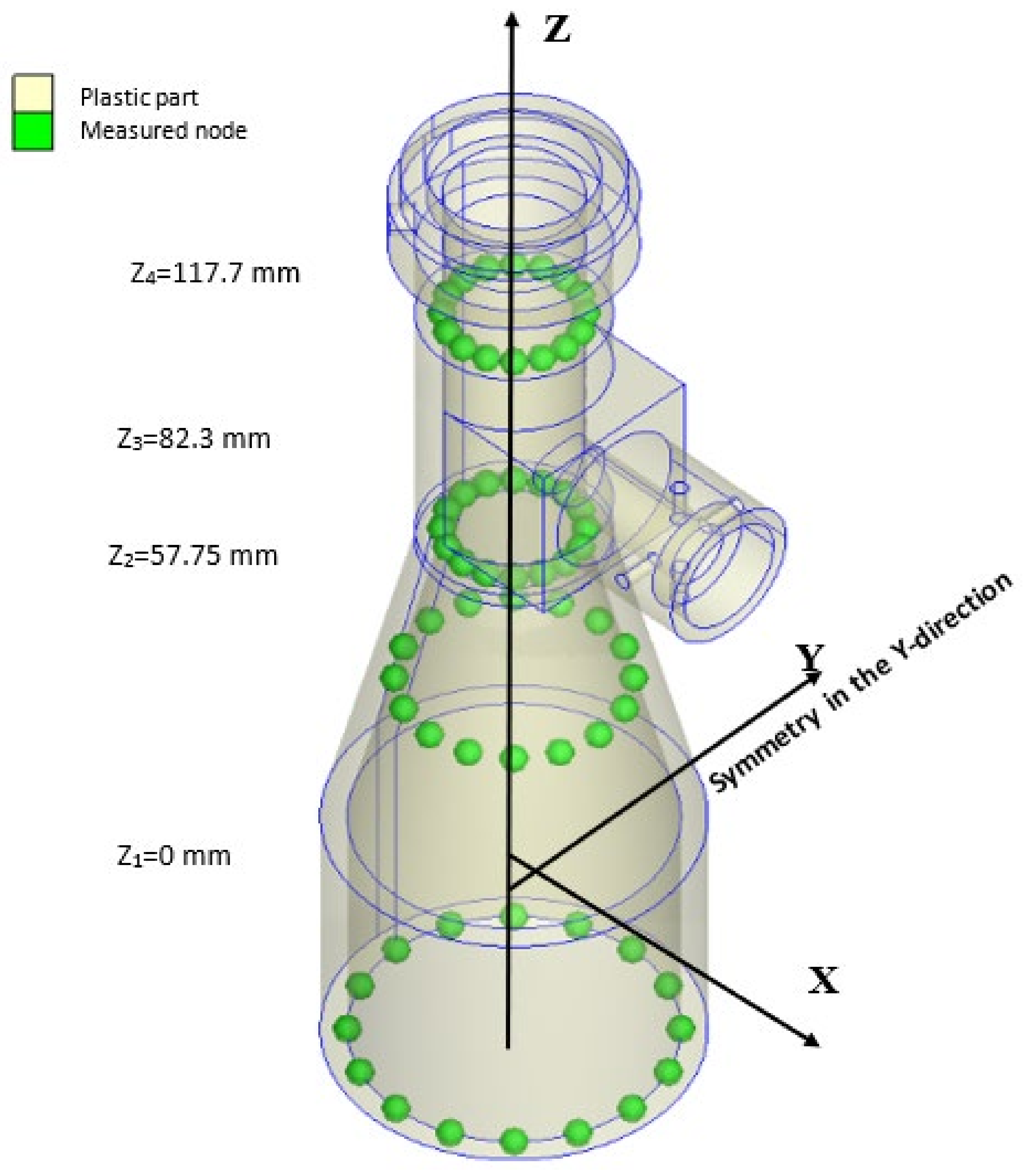




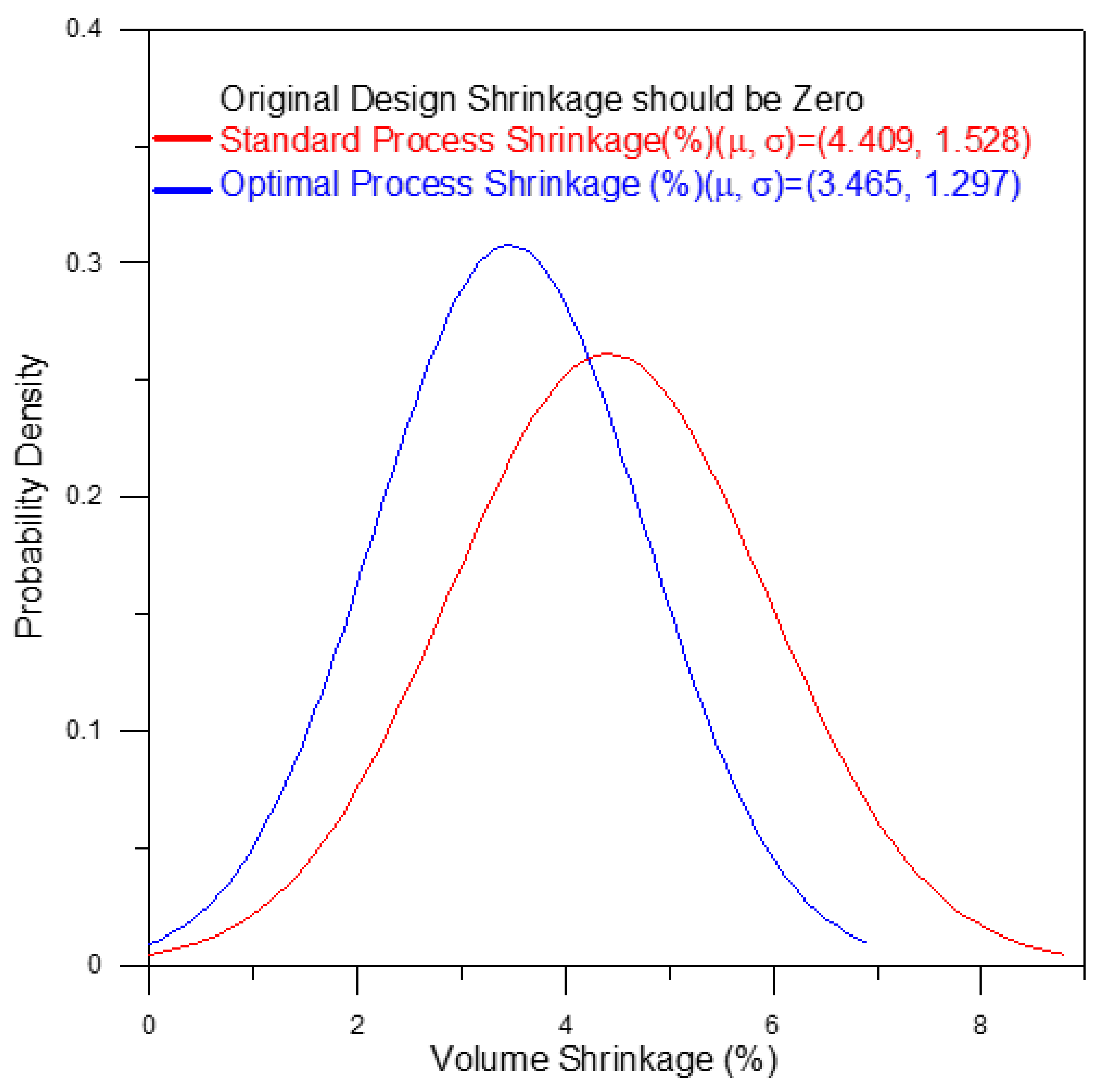
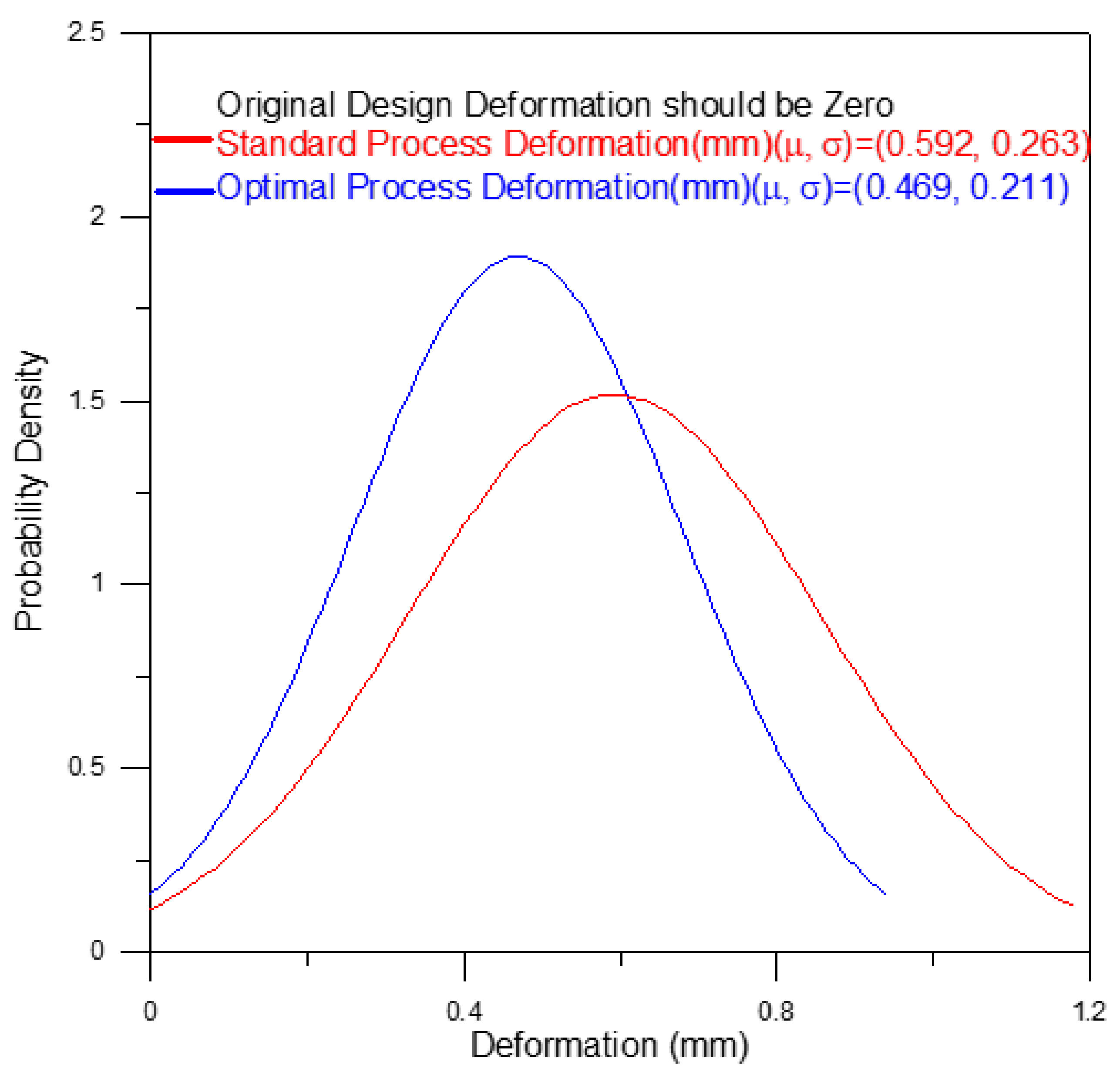
| Properties | Values | Unit |
|---|---|---|
| Density | 1140 | Kg/m3 |
| Mold shrinkage | 1.90 | % |
| Water absorption (24 h at 23 °C) | 1.30 | % |
| Tensile modulus | 3000 | MPa |
| Tensile strength at break | 55 | MPa |
| Tensile strain at break | 30 | % |
| Flexural maximum stress | 120 | MPa |
| Melt temperature | 263 | °C |
| Heat conduction coefficient | 0.25 | W/(m•K) |
| Coefficient of linear thermal expansion (after demolding)(23 °C to 85 °C) | 7 | E-5/°C |
| Viscosity vs. shear rate under different temperature | See Figure 4a | |
| P-v-T | See Figure 4b | |
| L16 (45) | A Injection Pressure (MPa) | B Packing Pressure (MPa) | C Melt Temp. (oC) | D Mold Temp. (oC) | E Cooling Time (Sec) |
|---|---|---|---|---|---|
| Level 1 | 180 | 180 | 275 | 70 | 11 |
| Level 2 | 200 | 200 | 280 | 80 | 13 |
| Level 3 | 220 | 220 | 285 | 90 | 15 |
| Level 4 | 240 | 240 | 290 | 100 | 17 |
| Standard Parameters | 200 | 200 | 280 | 80 | 13 |
| Trials | Processing Factors | Overall Roundness | Overall Concentricity | ||||||
|---|---|---|---|---|---|---|---|---|---|
| A Injection Pressure (MPa) | B Packing Pressure (MPa) | C Melt Temp. (°C) | D Mold Temp. (°C) | E Cooling Time (Sec) | /4 (mm2) | S/N (dB) | 4 (mm2) | S/N (dB) | |
| Standard Parameters | 200 | 200 | 280 | 80 | 13 | 0.002253 | 26.472 | 0.01487 | 18.278 |
| 1 | 180 | 180 | 275 | 70 | 11 | 0.002259 | 26.460 | 0.01569 | 18.043 |
| 2 | 180 | 200 | 280 | 80 | 13 | 0.002255 | 26.468 | 0.01488 | 18.274 |
| 3 | 180 | 220 | 285 | 90 | 15 | 0.002236 | 26.504 | 0.01397 | 18.549 |
| 4 | 180 | 240 | 290 | 100 | 17 | 0.002212 | 26.552 | 0.01309 | 18.832 |
| 5 | 200 | 180 | 280 | 90 | 17 | 0.002213 | 26.551 | 0.01534 | 18.141 |
| 6 | 200 | 200 | 275 | 100 | 15 | 0.002195 | 26.585 | 0.01417 | 18.486 |
| 7 | 200 | 220 | 290 | 70 | 13 | 0.002282 | 26.418 | 0.01472 | 18.321 |
| 8 | 200 | 240 | 285 | 80 | 11 | 0.002233 | 26.511 | 0.01314 | 18.813 |
| 9 | 220 | 180 | 285 | 100 | 13 | 0.002315 | 26.355 | 0.01658 | 17.804 |
| 10 | 220 | 200 | 290 | 90 | 11 | 0.002303 | 26.377 | 0.01562 | 18.062 |
| 11 | 220 | 220 | 275 | 80 | 17 | 0.002123 | 26.730 | 0.01256 | 19.012 |
| 12 | 220 | 240 | 280 | 70 | 15 | 0.002184 | 26.607 | 0.01257 | 19.007 |
| 13 | 240 | 180 | 290 | 80 | 15 | 0.002324 | 26.338 | 0.01684 | 17.736 |
| 14 | 240 | 200 | 285 | 70 | 17 | 0.002218 | 26.540 | 0.01458 | 18.362 |
| 15 | 240 | 220 | 280 | 100 | 11 | 0.002231 | 26.516 | 0.01367 | 18.641 |
| 16 | 240 | 240 | 275 | 90 | 13 | 0.002179 | 26.618 | 0.01242 | 19.058 |
| Roundness Optimized | 220 | 240 | 275 | 90 | 17 | 0.002111 | 26.755 | - | - |
| Concentricity Optimized | 220 | 240 | 275 | 90 | 17 | - | - | 0.01167 | 19.331 |
| Unit: Mm | Measured Planes | Least Square Circles | Roundness (ΔZq) | Concentricity (d) | |||
|---|---|---|---|---|---|---|---|
| Eccentric Coordinates | Radius | ||||||
| Xc | Yc | Zc | Rc | ||||
| Original Model | Z1 = 0 | 0 | 0 | 0 | 18.5 | 0 | 0 |
| Z2 = 57.75 | 13.25 | ||||||
| Z3 = 82.3 | 8 | ||||||
| Z4 = 117.7 | 8 | ||||||
| Standard Processing | Z1 = 0 | 1.740 × 10−1 | −2.405 × 10−4 | 0.9380 | 18.25 | 0.005442 | 0.1740 |
| Z2 = 57.75 | −6.099 × 10−3 | −2.107 × 10−4 | 57.91 | 13.07 | 0.08299 | 0.006103 | |
| Z3 = 82.3 | −5.464 × 10−2 | −1.300 × 10−4 | 82.13 | 7.896 | 0.03662 | 0.05464 | |
| Z4 = 117.7 | 1.618 × 10−1 | −6.092 × 10−4 | 117.0 | 7.916 | 0.02751 | 0.1618 | |
| Optimal Processing | Z1 = 0 | 1.528 × 10−1 | −1.852 × 10−4 | 0.7284 | 18.31 | 0.004390 | 0.1528 |
| Z2 = 57.75 | −1.698 × 10−2 | −1.591 × 10−4 | 57.89 | 13.11 | 0.08240 | 0.01698 | |
| Z3 = 82.3 | −5.810 × 10−2 | −9.810 × 10−5 | 82.17 | 7.918 | 0.03246 | 0.05810 | |
| Z4 = 117.7 | 1.401 × 10−1 | −5.558 × 10−4 | 117.2 | 7.934 | 0.02412 | 0.1401 | |
Publisher’s Note: MDPI stays neutral with regard to jurisdictional claims in published maps and institutional affiliations. |
© 2021 by the authors. Licensee MDPI, Basel, Switzerland. This article is an open access article distributed under the terms and conditions of the Creative Commons Attribution (CC BY) license (https://creativecommons.org/licenses/by/4.0/).
Share and Cite
Lin, C.-M.; Chen, Y.-J. Taguchi Optimization of Roundness and Concentricity of a Plastic Injection Molded Barrel of a Telecentric Lens. Polymers 2021, 13, 3419. https://doi.org/10.3390/polym13193419
Lin C-M, Chen Y-J. Taguchi Optimization of Roundness and Concentricity of a Plastic Injection Molded Barrel of a Telecentric Lens. Polymers. 2021; 13(19):3419. https://doi.org/10.3390/polym13193419
Chicago/Turabian StyleLin, Chao-Ming, and Yun-Ju Chen. 2021. "Taguchi Optimization of Roundness and Concentricity of a Plastic Injection Molded Barrel of a Telecentric Lens" Polymers 13, no. 19: 3419. https://doi.org/10.3390/polym13193419






